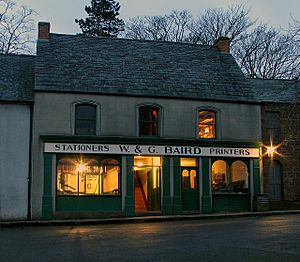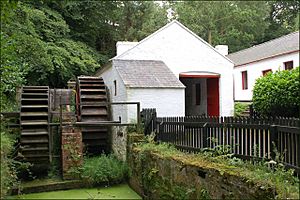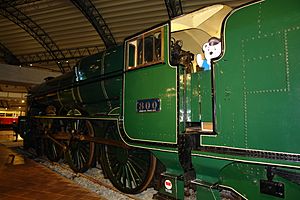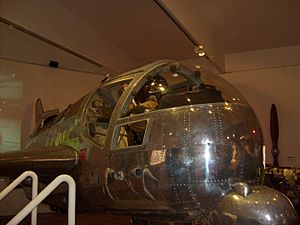Ulster Folk and Transport Museums facts for kids
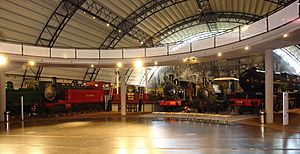
Rail Gallery of the Ulster Transport Museum
|
|
| Lua error in Module:Location_map at line 420: attempt to index field 'wikibase' (a nil value). | |
| Established | 1967 |
|---|---|
| Location | Cultra, Northern Ireland |
| Type | Aviation museum |
| Visitors | 172,712 (2019) |
| Public transit access | |
The Ulster Folk Museum and Ulster Transport Museum are two amazing places to visit in Cultra, Northern Ireland. They are about 11 kilometers (7 miles) east of the city of Belfast. These museums are among the best visitor attractions in Ireland!
The Folk Museum shows what life was like for people in Northern Ireland in the past. It helps us understand their traditions and how they lived. The Transport Museum is all about how people have traveled over time. It explores different ways of transport by land, sea, and air. These two museums are part of the National Museums NI group.
Contents
Ulster Folk Museum: Step Back in Time
How the Folk Museum Started
The Ulster Folk Museum was created in 1958. Its main goal was to save the old ways of country life. At that time, more and more people were moving to cities. Old traditions and ways of living were starting to disappear.
The museum bought a large piece of land, about 136 acres, in 1961. This land used to be an estate. The museum first opened its doors to visitors in 1964.
What You Can See at the Folk Museum
The Folk Museum is like a living history book. It has many old buildings and homes. These buildings were carefully moved from different parts of Ireland. They were then rebuilt, brick by brick, on the museum grounds.
You can walk through a recreated countryside from the early 1900s. You will see old farms, small cottages, and even farm animals. There is also a typical Ulster town called "Ballycultra." In Ballycultra, you can visit shops, churches, and different types of houses. There is even a Tea room where you can relax.
The museum often has special activities. You might see people cooking over an open fire. You can also watch demonstrations of old crafts like printing and needlework. These activities help visitors understand what daily life was like long ago.
Archives and Library
The museum also keeps important collections of old films, photos, TV shows, and sounds. It holds many radio and TV programs from BBC Northern Ireland. There are also over 2,000 hours of radio recordings in the Irish language. These recordings were made between 1972 and 2002.
The museum also has a collection of different dialects spoken in Ulster. It has a large library with more than 15,000 books. These archives and the library are open to the public during office hours.
Ulster Transport Museum: Journeys Through Time
How the Transport Museum Began
The Transport Museum started with a collection of old transport items in Belfast. These items were shown in a temporary place in the 1950s. In 1962, the collection moved to a new building.
In 1967, the Transport Museum joined with the Ulster Folk Museum. More land was bought at Cultra. The first new gallery for transport opened in 1976. However, most of the collection stayed in Belfast for a while.
In the 1990s, bigger galleries were built at Cultra. The rest of the collection then moved there. The railway gallery opened in 1993, and the road transport gallery opened in 1996.
What You Can Explore at the Transport Museum
The Transport Museum has a huge collection of vehicles. It tells the story of how people traveled in Ireland from ancient times to today. It has the largest collection of railway items in Ireland.
Railway Collection
The Irish Railway Collection shows over 150 years of railway history. You can see Steam locomotives, passenger trains, and goods wagons. There are also many railway items, interactive displays, and places for visitors.
One of the most popular attractions is the Great Southern Railways Class 800 locomotive No. 800 Maeḋḃ. This is one of the three largest and most powerful steam locomotives ever built and used in Ireland.
Road Transport Galleries
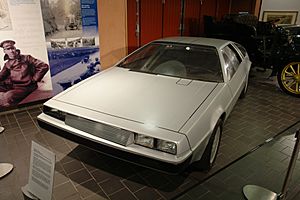
The Road Transport Galleries have a large collection of vehicles. These include bicycles, motorcycles, trams, buses, and cars. A very famous car on display is a DMC DeLorean. This car became well-known from the movie Back to the Future. It was made by the DeLorean Motor Company in Belfast.
Recently, the museum added items from famous local racers. This includes racing memorabilia and bikes from Stanley Woods. You can also see a Rex McCandless vehicle and an early Formula 1 racing car. In October 2023, a new display opened with 7 racing motorbikes. These bikes belonged to local racers like Joey Dunlop. They show the long history of road racing in Northern Ireland.
Titanic Exhibition
The museum has a special exhibition about the Titanic. It tells the story of how the ship was built, its journey, and its sinking. The Titanic has a strong connection to Northern Ireland. It was built in the Harland & Wolff shipyards, which are only a few miles from the museum. The updated Titanic exhibition is called TITANICa.
Aircraft Display
You can also see an experimental airplane called the Short SC.1. This plane was made by Short Brothers. It was special because it could take off and land straight up, like a helicopter. Only two of these planes were ever made. The one in the museum, XG905, crashed in 1963. However, it was repaired and flown again before being saved by the museum.
Getting There by Train
Cultra railway station is very close to the museum. It is on the Belfast-Bangor railway line. You can take a train from places like Sydenham, Belfast Lanyon Place, and Belfast Grand Central. You can also get there from Portadown and Newry. In the other direction, trains go to Bangor.
More to Explore
- List of heritage railways in Northern Ireland
- History of rail transport in Ireland
- National Museums NI
Other Museums to Visit
- Beamish Museum – County Durham, England
- Black Country Living Museum – Dudley, England
- Avoncroft Museum of Historic Buildings - Bromsgrove, England
- List of transport museums
- Ulster Museum – Belfast
- St Fagans National History Museum – Museum of Welsh Life, Cardiff, Wales.


